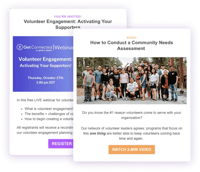Free Communication Templates
As a volunteer leader, it’s important to cultivate open and transparent communication channels, as they play a crucial role in fostering a highly engaged and motivated group of volunteers.
While most volunteer programs opt to communicate through traditional mediums like emails and newsletters, many are not taking full advantage of texting as part of a holistic volunteer communication strategy.
In today’s fast-paced digital world, your volunteers are constantly connected to their mobile devices. As a result, sending SMS messages to volunteers is an easy way to strengthen your existing volunteer engagement strategy and achieve greater impact.
In this guide, we’ll explore the ways that volunteer leaders can use text messaging to optimize volunteer engagement, drive impact, and nurture a more connected and committed volunteer network!
Why You Should Text Your Volunteers
Texting is a versatile tool that can be used to share all kinds of messages, media, and information. It’s a space to share news, communicate with your supporters, seek donations, and so much more.
Texting and other digital technologies have become a key part of communication in our modern society, and have revolutionized the way we connect, conduct business, and stay informed. Thus, sending SMS messages to volunteers is a key part of future-proofing your volunteer program.
By leveraging text messaging, volunteer leaders can promote higher volunteer retention, reduced cancellations, and faster communication, all while fostering a sense of community with their volunteers.
Here are just some of the reasons you should consider texting your volunteers:
- High open rates. Text messaging open rates can be as high as 98%, whereas email hovers around 20%. If you want to make sure your volunteers read your messaging, texting is the way to go!
- Instant communication. People tend to respond more quickly to texts than to other forms of digital communication. This makes it an efficient and reliable way to reach volunteers in real-time.
- Personalization. Texting is a more personal form of communication, and can cultivate a friendlier, stronger connection between you and volunteers.
- Encourages a conversation. Texting enables a two-way conversation between you and your volunteers. Through text messaging, volunteers can respond, ask questions, or easily provide feedback. This fosters a culture of openness and encourages volunteers to take an active role in your program.
- Cost-effective. Texting messaging is typically considered more cost-effective than other forms of communication mediums, like phone calls and direct mail.
Volunteers: Texting by the Generations
When building a volunteer engagement strategy geared towards multi-generational involvement, many volunteer leaders hesitate when deciding whether to include text messaging.
But volunteer managers shouldn’t worry - the fact is, Gen Z and Millennials are not the only ones who prefer texting!
A recent study from AARP found that 70% of people over the age of 50 own a smartphone and those between the ages of 50-69 prefer texting over email. This is great news for volunteer who want to give texting a try.
Note: In order to truly gain an understanding of whether or not your volunteers would embrace texting, it’s a good idea to first conduct a volunteer survey.

How to Text Your Volunteers
You know that volunteer engagement is a critical component of a successful program, and that sending SMS messages to volunteers is a great way to drive volunteer participation. But perhaps you’re left wondering how to get started with texting.
There are two main ways that you can send SMS messages to volunteers:
- Mass Texting Services for Nonprofits: You can use a SMS delivery service that allows you to send the same text message to your entire opt-in list or segment at once time. This is great for donation requests, new opportunity announcements, and organization updates.
- Peer-to-Peer Texting: This is a more personal form of text messaging that involves one-to-one or group SMSs between your staff and volunteers. Peer-to-peer texting is ideal for asking a specific volunteer a question, communicating last-minute updates, or when addressing a small group of volunteers.

How You Can Use Texting for Volunteer Engagement
Here are 5 ways you can use texting to foster a sense of community, boost engagement, and multiply the impact of your initiatives:
1. Invite Supporters to Events or Volunteer Opportunities
Text messaging should be included in a well-rounded volunteer recruitment strategy. Regularly send text messages to your supporters inviting them to sign up for a new volunteer opportunity, an upcoming event, or a volunteer shift that matches their availability.
2. Welcome and Onboard New Volunteers
Following volunteer sign up, send a warm, welcoming text that provides volunteers with essential information about the opportunity. You can also prompt new volunteers to complete a volunteer liability waiver or submit their certifications prior to their shift.
3. Communicate Time-Sensitive Issues
As a volunteer leader, speedy communication is essential when you experience inclement weather, unforeseen circumstances, event cancellations, or emergencies. Texting is faster than email at keeping volunteers informed of time-sensitive issues.
4. Send Shift Reminders
Text message reminders about upcoming shifts can serve as a gentle nudge that reduces no-shows and last-minute cancellations. We suggest sending a shift reminder 1 week, 1 day and 1 hour before a volunteer’s scheduled shift. Make sure your SMS includes essential information such as the location, date, and time of the opportunity.
5. Thank Your Volunteers
Texting is a great way to send personalized thank you messages after a volunteer has attended an event, left a donation, or completed a shift. Showing volunteer appreciation is important to long-term engagement and retention, and can make the difference between a lapsed volunteer and a recurring volunteer.
Text Messaging Best Practices
With a bit of strategy, volunteer leaders can grow program impact through messaging campaigns. Here are some best practices to keep in mind as you create text messages that inspire and engage your volunteers:
Build an Opt-In List
Prior to texting your volunteers, you must gain their consent to receive text messages. This is not only best practice, it’s the law. Verbal consent is enough for nonprofit organizations, though other organizations will likely need a digital or written opt-in. There are several easy ways you can automate the opt-in process. For example, you can include a text messaging sign-up option on your website, in the volunteer portal of your volunteer management software, or include it as part of your check-in process. Make sure that you clearly explain the frequency and type of messages volunteers can expect from your program. Be careful to honor and respect these promises, and ensure that your volunteers can easily opt-out of your text messages if desired.
Write Engaging Messages
Like traditional email marketing, your text messages should be concise and engaging for your volunteers in order to have the maximum impact. Within the first few lines, make sure that you clearly state the purpose of your event or volunteer opportunity. You should also communicate the benefits to your volunteers, as well as how their involvement will contribute to your mission or impact.
Include a Clear Call-to-Action
An effective call-to-action is a short sentence that asks the reader to make a decision or to take a desired action. When including a call-to-action, clearly state the action you want your supporters to take upon reading your message. Include the appropriate links to volunteer opportunity sign ups, event registration pages, or donation forms to make it easy for them to engage with you.
Note: It’s best not to include more than one call-to-action per text message.
Create Segmented Contact Lists
To get the biggest return on your text messaging efforts, volunteer leaders should segment their lists according to volunteer interests and preferences. Sending a targeted, relevant message adds a personal touch, and ensures that your supporters are receiving communications that align with their interests. This increases the likelihood that they will respond positively to your call-to-action. Some simple ways to segment your lists are by skills, interests, availability, volunteer status (active, lapsed, student), donor status, and certifications.
Personalize Your Messages
It’s always best practice to personalize your volunteer communications by addressing your supporters by their first name and/or appropriate titles. This simple touch adds a sense of care and familiarity, which can make your volunteers feel valued and seen as individuals and foster a sense of community.


Join 20,000+ Volunteer Leaders
Get impact-boosting articles, guides, and webinar invites to help grow your volunteer program
In today’s digital landscape, text messaging your volunteers is the way to go, and can be a game-changer for your volunteer program. By implementing these tips and tricks, volunteer leaders effectively harness text messaging in order to mobilize, retain, and engage their support base.





